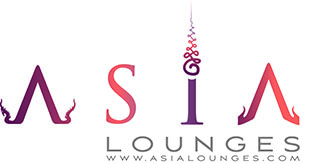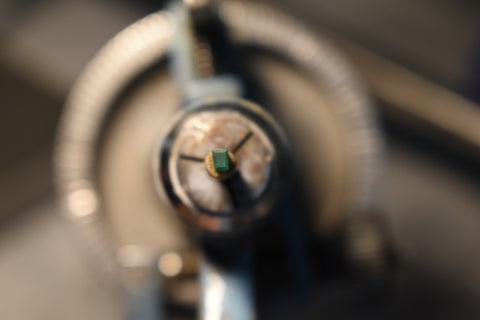Hey Loungers,
This week we welcome as our guest Ms. Victoria Raynaud, the young French gemologist who has quite the track record albeit her age and is one of the last people to have learned the traditional Swiss cutting technique!
She has worked diligently under our pal Vincent Pardieu both at GIA Bangkok and at DANAT Bahrain and is now setting her own activity as a gem cutting expert in Bangkok, Thailand!
But whom better than herself could tell us more about herself?
Victoria the floor is yours!
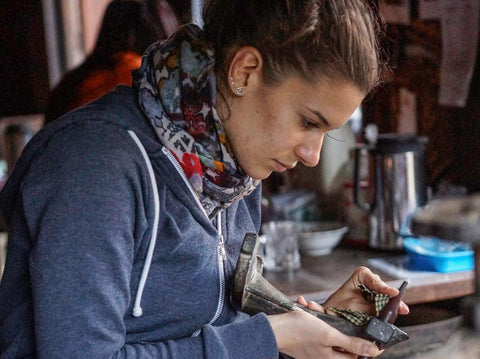
AsiaLounges: Victoria welcome to our column and thank you for answering our questions. Let us start with our traditional first question, tell us more about you: Who are you Victoria Raynaud?
Victoria Raynaud: Hi Simon, thanks for giving me the opportunity to do this interview. My name is Victoria Raynaud and I’m a gem cutter from France. I became a gem cutter when I was 14 when I started my training in Geneva. After 7 years in Geneva, I moved to Bangkok when I was offered an opportunity to work with Vincent Pardieu at GIA Bangkok. After 3 years of working with the Field Gemology team, I changed companies and began working with the research team at DANAT in Bahrain. Recently, I left DANAT and am getting ready to embark on new projects here in Bangkok.
AsiaLounges: While your lab career is indeed impressive we’d like to ask you questions about your gem cutting path today if you don’t mind. What drove you to start cutting? How did you discover your path? Was it a family thing or you got hooked into the trade like many of us did, by being attracted to our shiny little friends?
Victoria Raynaud: I grew up near a historical gem cutting region in France called “Jura”. When I was a kid we used to go up into the Jura mountains for skiing. There was a gem museum and shop on the way and I always asked my mom to stop there. This is how I fell in love with gems and minerals. One day, my mom asked me what I wanted to be when I grew up and I was clueless. She mentioned gem cutting, and it just clicked in my head.
My parents are both chefs and no one in my family was into gemstones or the gem business. We started to look around for an apprenticeship that I could enter into after I finished middle school. I was 14 at the time, so I needed it to be a properly certified program since school is obligatory in France until the age of 16. After some research, we realized that there was no such training program in France so we began to look in nearby Geneva, just across the border in Switzerland.
We went to a job fair in Geneva and I met a girl that had just finished her lapidary apprenticeship. She told me that there was only one company that was training new gem cutters and we arranged to visit the workshop. I was very shy at that time but I was also excited to see what a cutting studio was like. They explained to me the steps of cutting a stone and after some conversations we set up a trial. A few months later, I went into the workshop for a few days and learned to cut my first few gemstones. I loved the process, especially after I saw how my first stone came out but I didn’t know if they would take me on as an apprentice. Keep in mind I was a shy 14 year old girl from a country village. In the end, they accepted me and I started training at the end of the school year.
My apprenticeship took the place of high school. I was in the workshop 4 days a week and then on the fifth day, we would do a group class at the Geneva School of Applied Art with the jewelry students, which covered basic gemology and jewelry design. During my apprenticeship, I learned to cut every shape and almost every type of stone. At first, I started practicing on synthetics but by the end of the first year I was cutting customers stones. 3 years later, I passed my lapidary exam.
Lapidary is considered a rare job in Europe and I did well on the test, so I was given an award from the city of Geneva. I continued working at the cutting factory for 2 more years, cutting valuable stones for the Swiss watch and jewelry industry. During that time, I started to learn English and also started thinking about gemology. One of my coworkers was a gemologist and a cutter and it seemed like I might have more opportunities in the future if I knew gemology as well as cutting.
I quit working at the studio and went to Montreal to take the FGA course at the EGM school. After I graduated, I went back to France to look for a gemology job in Geneva. I couldn’t find job in that field, so I went back to working at the cutting studio. By that time, I was 21 and was open to new work opportunities. I wanted to go deeper into the gem trade but wasn’t quite sure how to do it. Eventually, I met Vincent Pardieu at a talk in Paris. After his presentation, I went up to talk to him and I told him I wanted to go on a field gemology trip with him. Later, when I sent him my CV and he saw that I was a gem cutter as well as a gemologist, he offered me a three-month internship that later turned into a full-time job at GIA Bangkok.
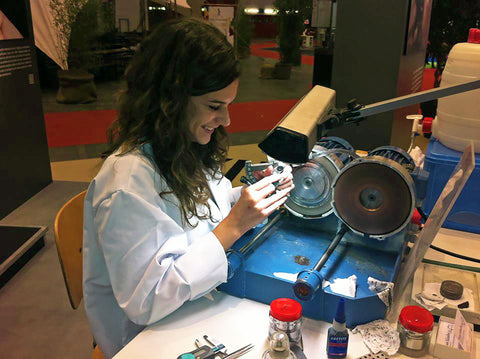
Demonstrating the Swiss Cutting Technique at a Fair in Geneva in 2012.
AsiaLounges: Many people are pitting western cutting styles versus asian or so called native cutting styles. According to you, what is the reason for such segmentation and is it really that different? Personally I have a tough time seeing the difference between the so called Idar cut and a native Chantaburi “Saparot” cut if not for the meeting points, what’s your take on this? Could you tell us what makes one better or worse than the other?
Victoria Raynaud: Most of the stones that I recut in Geneva were from these “native cut” stones so I have seen a lot of them in my career. The customers we had in Switzerland were asking for top quality cutting and polishing as well as specific shapes so we would buy native cut stones from Bangkok and other places and then cut them to the customer’s specification. Depending on who your customer is, native cut stones can be acceptable for normal jewelry use but for Swiss watch standards, they could never work.
One problem with native cut stones is that they aren’t cut in a very precise way. If you need 100 6x9 baguettes stones and you buy them at a gem market, they won’t all be exactly 6x9 and they won’t all be the same shape of baguette. Part of our job is to cut to very exact specifications, so when I cut 100 6x9 ovals, they are exactly 6.00mm x 9.00mm and each stone will be the exact same shape, whether that is a baguette, an oval or an emerald cut.
The Swiss Cut tapered baguette emerald with perfect proportions, halfway through the cutting and polishing process.
Another thing that separates native cut from Swiss precision cut is going to be the perfection of the meet points and the proportions of the stones. Many native cut stones are cut for weight not beauty and that means that if they start with a flat piece of rough, they will cut a flat faceted stone and because the proportions aren’t correct there will be a window, which reduces color and brightness in the center of the stone. When I cut stones, I make sure that the depth and angle of the stone is correct so that the entire stone shines and sparkles with no window.
The meet points on my stones will always be where they are supposed to be whether it’s a 0.5 ct stone or a 20 ct stone, where the meet points on native cut stone are usually in random places and with extra facets. Finally, the difference between native and precision cut is the polish. Sometimes the polish on native cut stones is good but sometimes if you look closely you will see that half the facet is not polished or you will see noticeable polishing lines, which for us is unacceptable.
Most native cut stones are done on jamb peg machines but actually it’s not the machine that makes the most difference but the skill and attention of the cutter. If you are hired to cut fast and make the stones heavy, then that will become your style. For me, I was trained to cut perfect stones, so that’s what I do.
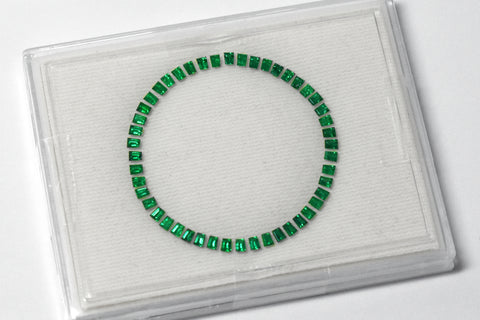
The final product of Swiss cutting, a perfect emerald ring that can be set around a watch dial.
AsiaLounges: Besides fashion and trends, is there a marketed reason why some cuts are more popular than others and can fetch a premium prices when sold?
Victoria Raynaud: This is a difficult question because it really depends on the stone. For instance, you will never see an expensive ruby cut into fancy shapes because it so important to maintain weight. It feels like people still prefer the classic cuts though many people are asking us for new styles as well. The new styles can be taken to the extreme with concave special effects or designs with hundreds of facets, but it seems like our customers are asking for something in between, something classic but with a new twist.
There are some cutters who have become quite famous for their style and people seem willing to pay more for a “celebrity cut” but in general I think it’s more about the stone itself and what the cutter can bring out of it, whether that’s with a classic cut or something more modern and fancy. It seems like the classic mixed cut that Yavorskyy is known for is getting a lot of attention right now, even though this is actually a very classic cut. Doing a classic cut with proper angles, proportions, and polish makes a big difference between what we do and what a native cutter would do, in terms of color, shine, and beauty.
AsiaLounges: Further to the previous question, the team and myself have been wondering for a while, in your opinion, in this day and age, why do people continue to use native cuts rather than more precise and expensive looking type cuts on gems?
Victoria Raynaud: I think it comes down to price, time and availability. The cost of having a stone cut by a “native cutter” could be as cheap as one dollar per carat cut in some countries but when cutting becomes that cheap, I think almost anyone can see the poor quality. Like any product, a high-quality stone takes more time and more experience and both of those things cost money.
Availability makes a huge difference as well. It’s quite easy to come to Bangkok or go to one of the many trade shows around the world and find an abundance of native cut stones, some being better than others. It’s not so easy to find well-cut stones on the market in large quantities. There are some companies who are well known for their high quality of cutting but unfortunately these cutting houses are still in the minority. Even in these fine cutting houses, well-cut stones are only available on a stone by stone basis. If you are building a line of jewelry and need 500 of the same size stone, chances are likely that you won’t be able to find 500 perfect cut stones unless you commission someone to cut them for you.

A Burmese Grey Spinel that has been recut from a “native cut”
AsiaLounges: In a hypothetical world where cutters could only do one type of cutting or shape, which would you rather specialise on and why?
Victoria Raynaud: Is it ok if I choose two? For me, my favorite cut is the emerald shaped princess cut. If you look on my instagram you will see a lot of these cuts. This cut can really bring out hidden colors in dark stones such as grey blue spinels. The cut works well on light stones as well and makes them really shiny. For me I think the emerald shape is more interesting than a rectangle and usually works better for the rough as well because you would normally have to cut a stone slightly smaller to make a perfect rectangle.
My next favorite cut is the oval shaped mixed cut. The combination of a brilliant top and a step cut bottom saves the most weight and looks great when done right. The oval is a very classic shape that will never go out of fashion and again it’s a shape that works well for a lot of rough and doesn’t waste too much weight.
AsiaLounges: Independently of sales related issues and profitability, what is your gem of choice when cutting and why?
Victoria Raynaud: Spinels! They are simple to orientate because you don’t have to worry about pleochroism, easy to cut because they are not too hard, and easy to polish because they are not too soft. They can be very clean, they come in a lot of colors, and they have a really shiny luster.
AsiaLounges: Is it the same than your favourite gem jewellery wise?
Victoria Raynaud: No, actually for jewelry I really like opals. I’ve been to Australia twice, once as a teenager when I wanted to learn English and another time with Vincent on a field gemology trip. I already loved opals from my childhood but I appreciated them even more after visiting the opal mines and seeing the passion that the people there had for their local stones. Lightning Ridge was an especially great place. It’s opal city, full of interesting people who are obsessed with opals. We were invited to come and see a mining operation on the day that the miners pulled the stones of the tumbler. We got to see the stones when they first hit the sun light. The miners were having so much fun pulling these sparkling gems out. They love the surprise of finding beauty in the Earth. Since then, I’ve created some pieces of jewelry with Australian Opals for myself and for customers.
Australian opals that Victoria had set in a ring
AsiaLounges: I know that much of your work these days is done in laboratories. Can you tell us exactly what is your role inside a laboratory?
Victoria Raynaud: I’ve been working in labs for the last six years and during that time I’ve had a number of different roles. My main responsibility is to prepare the rough stones that Vincent brings back from his field gemology expeditions. When the gemstone samples arrive at the lab they are in rough form, straight from the hands of the miners. Before any research tests can be done by the lab gemologist, such as chemistry and spectroscopy, the stones need to be prepared. That’s where I come in. My job is to turn the rough stones into perfectly polished, perfectly oriented wafers that can then be studied by the lab gemologists.
For pleochroic stones such as sapphires, rubies, and emeralds, we need to make sure that the sample is cut in alignment with the C-axis. We want all the research data to be standardized and if we don’t do this, then we won’t be able to fully trust our test results. The process of aligning the stone to the C-axis is quite difficult and needs a high level of precision in order to be accurate. We use a special machine to help us. Sometimes the samples are very small and if we misorientate the sample before cutting, we lose the sample. The cost of the sample is quite high if you consider that someone has had to fly across the world, find the mine, acquire the sample and bring it all the way back to the lab. If we don’t process the stones correctly then all of that work has been done for nothing.
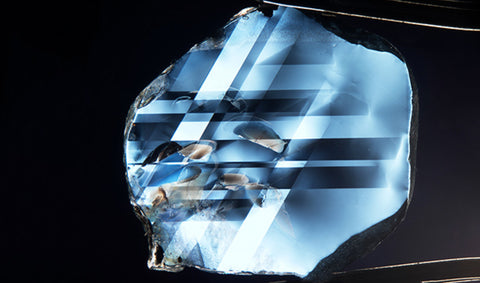
An example of a sapphire cut into a flat wafer and seen through a crossed polarized filter. Photo by Victoria for © GIA Gem and Gemology Summer 2017
The end goal of all this research is origin determination. When a customer brings their ruby or sapphire to the lab and wants to know exactly what country it’s from, it’s up to our research and our sample database to help figure that out. The only way you can accurately determine the origin of a stone is by comparing it to other stones from the same location, using several types of advanced tests. If I wasn’t there to process all those stones, the data hidden inside them wouldn’t be able to be catalogued.
Another big part of my job has been to improve the speed and quality of the polishing of the samples. Because of my formal lapidary training, I have been able to improve the techniques in the labs I have worked for. In addition, it was my responsibility in DANAT to build the fabrication section from the ground up. I designed the layout and workflow of the area as well as chose which machines we would use to get the job done efficiently and quickly.
One of my favorite parts of my job is photomicrography. Part of polishing the samples is also about creating polished windows that allow the camera to look into the stone to see inside it. During my time in GIA as well as DANAT, I have been responsible for orienting samples in order to make good photos. I was also one of the people that took the photos and processed them on the computer. Photomicrography is an important part of origin determination research because we use the inclusion data captured in the photos to compare one region from another. It’s also really fun!
Iridescent rosette pattern inside of a Burmese sapphire. Photo by Victoria for © GIA Gem and Gemology Spring 2017
AsiaLounges: What is your take on all the eco friendliness and other ethical fads in the gem trade such as synthetics and ethically sourced gems?
Victoria Raynaud: The concept of ethically sourced stones is a beautiful idea and a few people are able to guarantee that stones are moving along an ethical path from mine to market. However, I think right now it’s a buzzword that’s being used as a marketing tool that not everyone uses in a responsible way. It’s a vague term that can be interpreted in many ways. Some people think ethical means supporting a big company that does everything by the letter of the law. Some people think ethical means supporting small artisanal miners, despite the fact that they might be unlicensed. In both situations, the final customer tends to hear rumors about one thing or the other and makes a broad generalization about what is ethical. These generalizations are actually bad for the whole market because they make customers want to avoid a country or region, and that hurts everyone in the country.
Regarding synthetics, it’s a different world of psychology. I’ve seen people calling synthetics “eco friendly” or ethical but in reality, the manufacturing process used to create synthetic stones is harmful in a different way, due to the chemicals and energy used during the production. Unfortunately, giving value to synthetic stones takes away value away from natural stones and directly hurts the small miners that consumers think they are trying to protect. I’ve seen many of these small mining operations around the world on my field gemology trips with Vincent. A lot of small miners are actually farmers and they use mining to bring an extra income in during the farming off-season to feed their family.
I think synthetics are a good option for a small budget or for beginning gem cutters who want to practice but I don’t think it’s right to call synthetics eco-friendly or ethical since we really don’t know all the facts behind the manufacturing process.
AsiaLounges: Are you and your husband Justin’s company (Magus Gems) proposing products that answer this kind of problem? I mean ethically sourced gems with full on traceability?
Victoria Raynaud: The colored stone market is complicated. We get stones from many different sources, sometimes miners, sometimes brokers. Sometimes we know that the stones come from an ethical region and sometimes we trust the broker, but unless we’ve seen the mine with our own eyes, it’s impossible to say if the working conditions that the stones come from would agree with every customer’s definition of ethical. We prefer to focus our efforts on something that we know and can have some degree of control over which is the cutting. We work with cutting houses here in Bangkok and we know the owners, we’ve seen the conditions, we know that the workers are receiving a good salary and working in conditions that we would also work in.
Our focus right now is moving towards fair trade gem cutting. It’s not something we’ve really started to promote yet but it’s something that we are working towards. If our customers want to place a big order with one of the cutting factories we work with, we want to make sure that the cutters are making a good salary and making good cuts. In Thailand, being a gem cutter is not really considered a good job. Most young people don’t want to train as gem cutters anymore. We are hoping that through our efforts, we can help people see gem cutting as an art and understand the value of the gem cutter, who is one of the cornerstones of the jewelry industry.
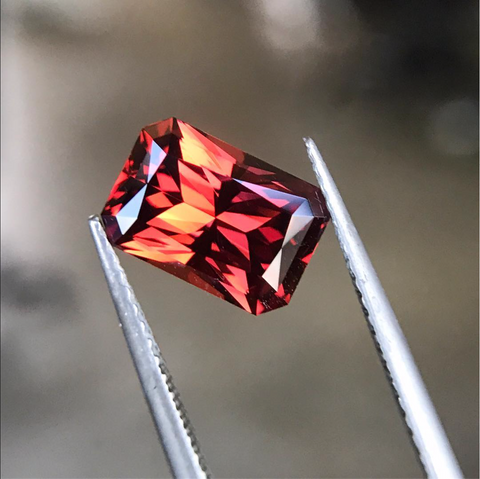
A garnet cut in Victoria’s signature cut: an emerald shaped princess cut
AsiaLounges: We are reaching the end of this interview and we’ll need to know more about reaching out to you and Justin should our readers wish to get in touch with you guys?
Victoria Raynaud: Your readers can follow me on instagram at @victoriaraynaud. I regularly post photos of my stones as well as some of the adventures I go on. If people want to see what we have for sale they can check out our web shop at www.magusgems.com. If people have stones that they’d like to see cut they can email my husband Justin, who runs the online shop at justinkprim@gmail.com
AsiaLounges: Last but not least, our traditional advice to young generations and people that would want to follow in your footsteps. Could you please give our readers three advices or books that you’d recommend them to read or follow?
Victoria Raynaud: I’ll recommend two books. One is related to my work as a cutter and one related to my work as a photomicrographer.
The first one I will recommend is the first book on cutting I ever bought. The book is written in French and I will point out that an instructional book about cutting in French is pretty rare. It’s called Manuel de Lapidairerie: La Taille des pierres à Facettes by Daniel Pogorzelski. The book never leaves my cutting station. It’s a great book about cutting that also talks about angles, optics, and light return and features different diagrams as well.
The second is the Photoatlas of Inclusions in Gemstones by Gubelin and Koivula. This is an amazing book full of photos of gemstone inclusions. I like to use it as a reference when I am taking my photos in the microscope. It’s also just a fun book to look through and makes you appreciate the inclusions that gem cutters are usualy afraid off.
My advice to the young generation: Be curious and don’t be scared to go out of your comfort zone. If you wait for opportunities to come to you, you will be waiting forever. If I wouldn’t have been brave enough to quit my salaried job in Geneva to go take an internship in Bangkok with someone that I had only recently met, I would never have been able to build up such an interesting life and career and have all these amazing opportunities to travel.
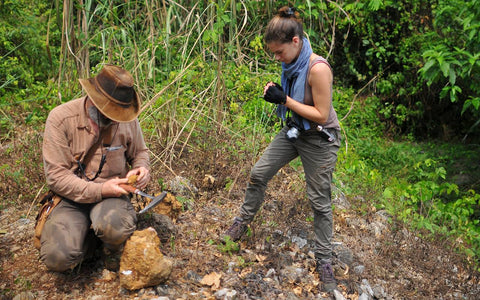
Victoria and Vincent Pardieu Hunting for Rubies on a Field Expedition in Vietnam in 2014.
AsiaLounges: Thank you very much Victoria for being with us today, I am convinced that our readers, the Loungers, have enjoyed this interview as much as we did enjoy writing these lines.
As for us, we will meet you again soon in the Lounges with more exciting content! If you have enjoyed this content please let us know by liking, commenting and sharing our work with your family and friends and on your favourite social media platform. Don't forget that you can also support A Gem Dealer's Journal through our Patreon's Page. It will help us a lot continue with our work!
Should you have any questions, or topic that you’d like us to research or look into for a future interview, feel free to let us know by contacting us at simon@asialounges.com, it is always a pleasure to dig further into the world of gems and gemology!
For all the rest, feel free to take a look at our gem and jewellery collection as well as to contact us should you be interested in getting one of our famed bespoke pieces of AsiaLounges Jewellery.
See you again in the Lounges,
